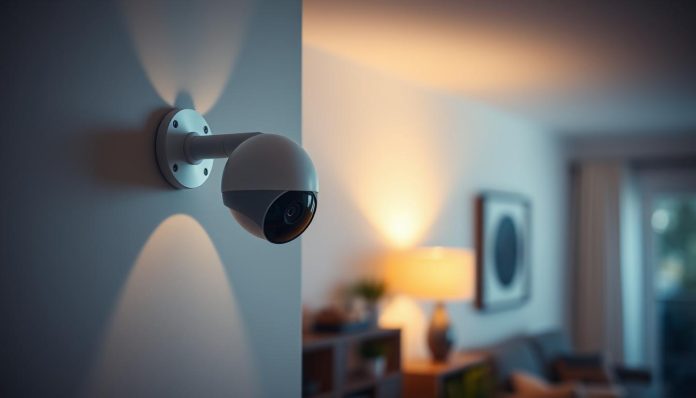Video surveillance is getting more common. Businesses use it for security and to work better. But, they must follow strict privacy laws.
GDPR and CCPA set clear rules for video data. This is key for companies with home security cameras.
Following these laws is a must. It helps keep your customers’ trust and protects your business’s image.
Key Takeaways
- Understand the implications of GDPR and CCPA on your business’s use of home security cameras.
- Implement measures to ensure compliance with these regulations.
- Recognize the importance of video data protection for maintaining customer trust.
- Stay updated on the evolving landscape of privacy laws affecting your business.
- Consult with legal experts to ensure your business is meeting all necessary legal requirements.
Understanding Home Security Cameras
In today’s world, home security cameras are key in keeping homes safe. They help prevent threats and watch over your home. Knowing how these cameras work is important for their benefits and legal use.
What Are Home Security Cameras?
Home security cameras are tools for watching over homes and businesses. They are part of a surveillance system that keeps places safe. You can use them inside or outside, based on what you need.
These cameras record video and sometimes audio. They give a visual look at what’s happening around your property. You can watch them on a system or through your phone or computer.
Different Types of Home Security Cameras
There are many types of home security cameras for different needs. Here are a few:
- Wired Cameras: These cameras need cables for power and recording.
- Wireless Cameras: Wireless cameras use batteries or a power source but send data wirelessly. They’re easy to place anywhere.
- Indoor Cameras: Made for inside use, these cameras are smaller and not weather-proof.
- Outdoor Cameras: Built for the weather, outdoor cameras are strong and have night vision.
To follow privacy laws like GDPR and CCPA, it’s key to know how these cameras work. They collect data, and understanding this is crucial. This knowledge will help us in the next parts about legal rules for using home security cameras.
Overview of GDPR
The General Data Protection Regulation (GDPR) has changed how we handle data in the EU. It affects businesses all over the world. This regulation sets new rules for collecting, storing, and using personal data. It also gives people more control over their own information.
GDPR is based on key principles that companies must follow. These principles help ensure personal data is treated with respect and care.
Key Principles of GDPR
GDPR has several key principles. These are the foundation of the regulation. They help guide how personal data should be handled.
- Lawfulness, Fairness, and Transparency: Personal data must be processed lawfully, fairly, and in a transparent manner.
- Purpose Limitation: Data should be collected for specific, legitimate reasons and not used in ways that are incompatible with those reasons.
- Data Minimization: The data collected should be just enough, relevant, and necessary for the intended purpose.
- Accuracy: Personal data must be accurate and, when needed, kept current.
- Storage Limitation: Data should be stored in a way that allows for identification of data subjects for no longer than necessary.
Rights of Individuals Under GDPR
GDPR gives individuals important rights. These rights include:
- The Right to Access: Individuals have the right to access their personal data and information about how it is processed.
- The Right to Erasure: Also known as the “right to be forgotten,” individuals can request the erasure of their personal data under certain circumstances.
- The Right to Object: Individuals can object to the processing of their personal data for certain purposes, such as direct marketing.
- The Right to Data Portability: Individuals have the right to receive their personal data in a structured, commonly used, and machine-readable format.
Understanding and following GDPR is not just a legal requirement. It’s also a way to gain your customers’ trust. By showing you care about protecting their personal data, you build trust.
Overview of CCPA
Understanding the California Consumer Privacy Act (CCPA) is key for businesses in California. The CCPA gives California residents control over their personal data. It’s a major privacy law.
Key Principles of CCPA
The CCPA has several important principles. These guide how businesses handle personal data. The main points are:
- Transparency: Businesses must clearly state what data they collect and how it’s used.
- Consumer Rights: Californians can know what data is collected, access their data, and ask for its deletion.
- Opt-out Option: Consumers can choose not to have their personal data sold.
- Non-discrimination: Businesses can’t treat consumers unfairly for using their CCPA rights.
Rights of Californians Under CCPA
CCPA gives Californians several important rights. These include:
| Right | Description |
|---|---|
| Right to Know | Consumers can ask for details on the personal data a business has collected. |
| Right to Delete | Consumers can ask a business to delete their personal data. |
| Right to Opt-out | Consumers can tell a business to stop selling their personal data. |
Knowing these rights and their impact on your business is vital for following the law.
How GDPR and CCPA Affect Home Security Cameras
Home security cameras are getting more common. It’s important to know how GDPR and CCPA affect them. You need to understand the legal requirements and privacy regulations for data collection and processing.
Home security cameras raise big concerns about data privacy. GDPR and CCPA have big rules for these cameras. These rules are about data collection and processing.
Data Collection and Processing Implications
Home security cameras collect and process a lot of personal data. This makes them follow strict privacy regulations. You must make sure your cameras follow these rules by protecting data well.
The data from home security cameras can include things like facial recognition and video recordings. You must tell people how this data is used. You also need to get their consent.
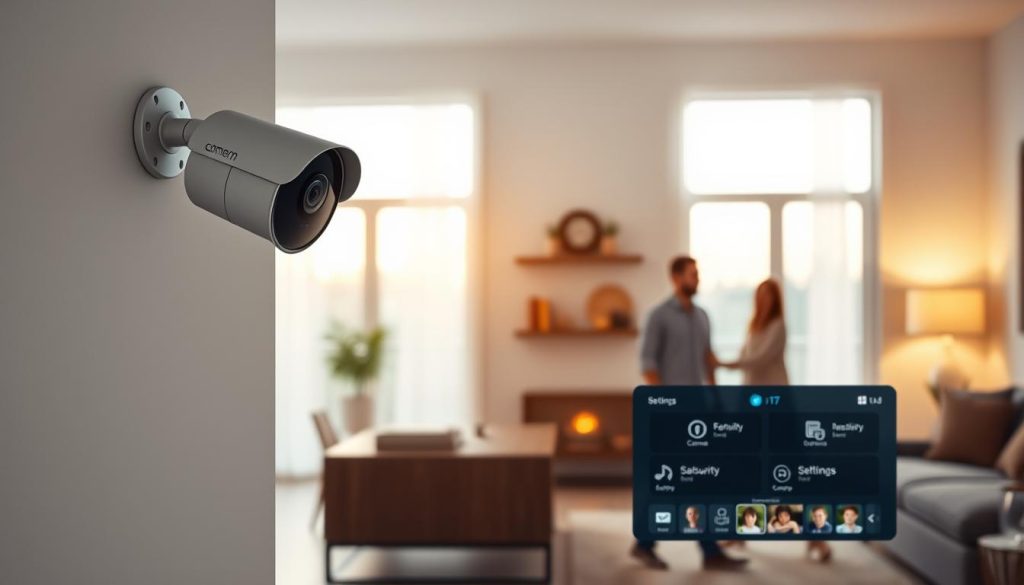
Requirements for Transparency and Consent
GDPR and CCPA say you must be clear about data use and get consent. You need to tell people how their data is used and protected.
To follow these rules, you should put up clear signs about security cameras. You also need to make privacy policies easy to find. And, you must get clear consent when needed.
By following these legal requirements and privacy regulations, you can use home security cameras legally. This protects your property and the privacy of others.
Compliance Checklist for Home Security Cameras
To follow laws like GDPR and CCPA, you need a detailed checklist for your home security cameras. It’s key to meet these rules to avoid legal trouble and keep trust with your customers or residents.
Identifying Personal Data Collected
The first step is to know what personal data your cameras collect. This includes:
- Video footage of individuals
- Audio recordings, if applicable
- Metadata, such as timestamps and camera locations
Do a thorough audit of your systems to find all data collection points. This will show you how much personal data you handle.
Implementing User Rights
GDPR and CCPA give people certain rights over their personal data. You must set up ways to respect these rights, including:
- Right to Access: People can ask to see the data collected about them.
- Right to Deletion: You must delete personal data, like footage or recordings, when asked.
- Right to Object: Sometimes, people can object to how their data is used.
By doing these things, you not only follow the rules but also build a culture of openness and trust.
The Importance of User Consent
Getting valid consent for home security cameras is a must, not just a good idea. It’s required by GDPR and CCPA. You must tell people they’re being recorded and get their okay.
User consent is key to data protection laws. It lets people control their personal data. For home security cameras, this means being open about what data is collected and how it’s used.
What Constitutes Valid Consent?
Valid consent under GDPR and CCPA must be informed, specific, and freely given. You must clearly explain how your cameras work and what data they collect.
- Be clear and concise in your communication.
- Avoid using complex legal jargon that might confuse individuals.
- Provide easy-to-understand information about data processing.
Managing Consent in Practice
Managing user consent well means having good systems for getting, recording, and managing it. You should have a way for people to easily take back their consent if they want to.
| Consent Management Task | Description | Best Practice |
|---|---|---|
| Obtaining Consent | Clearly inform individuals about data collection and usage. | Use simple, straightforward language. |
| Recording Consent | Keep a record of when and how consent was obtained. | Use a secure, accessible database. |
| Managing Consent Withdrawal | Allow individuals to withdraw consent easily. | Provide a clear, simple process for withdrawal. |
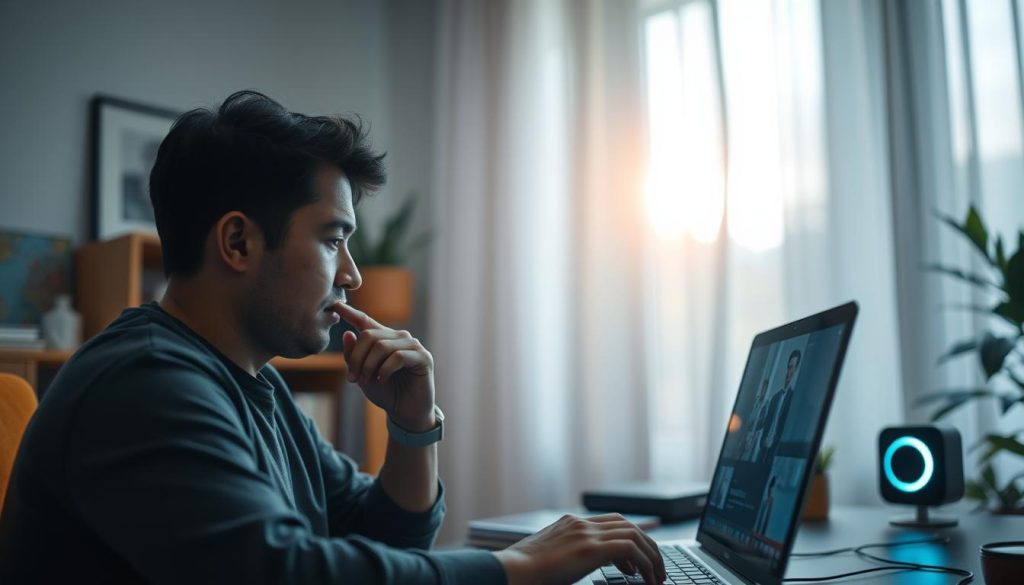
By focusing on user consent and good consent management, you can follow data protection laws. This builds trust with the people whose data you’re handling.
Privacy Policy Essentials for Cameras
Home security cameras need a solid privacy policy to work right. This policy should explain how data is handled and what users can do. It’s key to follow Privacy Regulations and keep Secure Home Monitoring.
Crafting a Comprehensive Privacy Policy
A good privacy policy tells users how their data is used. It should say what data is collected, why, and how users can control it. This is important for following privacy laws.
When making a privacy policy, think about these points:
- Data collection practices and purposes
- User rights and how to exercise them
- Data protection measures in place
- Procedures for handling data breaches
Key Elements to Include
Your privacy policy should be clear and easy to read. Here are important parts to include:
| Element | Description |
|---|---|
| Data Collection Practices | Explain what data is collected by your home security cameras and why. |
| User Rights | Outline the rights of individuals under privacy laws, such as the right to access and erase their data. |
| Data Protection | Describe the measures you take to protect the data collected by your cameras. |
By adding these elements and keeping your policy up to date, you stay in line with Privacy Regulations. This builds trust with your users.
Data Protection Impact Assessments (DPIAs)
DPIAs are key to making sure your home security cameras follow privacy laws like the GDPR. A DPIA is a way to find and fix privacy risks in your data processing. This includes using home security cameras.
When to Conduct a DPIA
Under the GDPR, you must do a DPIA if your home security cameras might harm people’s rights and freedoms. This is true if:
- You’re handling sensitive data, like video that can identify people.
- You’re using new tech that could hurt privacy.
- You’re watching public areas on a big scale.
Doing a DPIA in these cases lets you tackle privacy risks early. It also shows you’re following the GDPR.
How to Conduct a DPIA for Home Security
To do a DPIA for your home security cameras, just follow these steps:
- Identify the Need for a DPIA: Check if you need a DPIA for your home security cameras based on the GDPR rules.
- Describe the Processing: Explain how you’re using your home security cameras. Talk about the data you’re handling and why.
- Assess Necessity and Proportionality: See if using home security cameras is really needed and fair for your goals.
- Identify and Assess Risks: Find out what risks there are to people’s rights and freedoms. Then, figure out how likely and big these risks are.
- Mitigate Risks: Take steps to lessen the risks you found. This could mean changing your camera views, adding access controls, or making your data safer.
By taking these steps, you can make sure your home security cameras meet GDPR standards. This way, you respect people’s privacy.
Common Compliance Pitfalls
When dealing with home security cameras, knowing common compliance issues is key. Businesses must watch out for mistakes that can break privacy laws like GDPR and CCPA.
Lack of Transparency
A big problem is the lack of transparency about data use. You need to tell users what data you collect, how it’s used, and who sees it. Not doing this can lead to big fines and harm your reputation.
To stay clear of this, make sure your privacy policies are easy to find and simple to understand. Transparency helps build trust with your users.
Ignoring User Rights
Another big issue is ignoring user rights. GDPR and CCPA give people certain rights over their data, like access, correction, or deletion. You must have ways to respect and follow these rights.
| User Right | GDPR | CCPA |
|---|---|---|
| Right to Access | Yes | Yes |
| Right to Correct | Yes | No |
| Right to Delete | Yes | Yes |
By knowing and honoring these rights, you can dodge compliance problems and keep a good relationship with your users.
Best Practices for Compliance
To follow data protection rules, several steps can be taken for your surveillance systems. Staying compliant is not just a one-time thing. It’s a continuous effort that needs constant checking and bettering.
Regular Training for Staff
One key practice is to give regular training for staff who work with surveillance systems. This training should teach about data protection, privacy, and how to handle personal data.
- Training should be thorough and updated often to keep up with rule changes.
- Staff need to know their roles in protecting data.
- Tests or quizzes can check if staff really get and follow data protection rules.
Using Updated Technology
Another important thing is using the latest technology for safe data handling. This means using the newest encryption, secure storage, and software.
| Technology | Benefits | Compliance Impact |
|---|---|---|
| Modern Encryption | Keeps data safe from unauthorized access | Boosts data security and meets compliance |
| Secure Data Storage | Stops data breaches | Lessens the chance of not meeting compliance |
| Up-to-date Software | Fixes security holes | Keeps compliance with security rules |
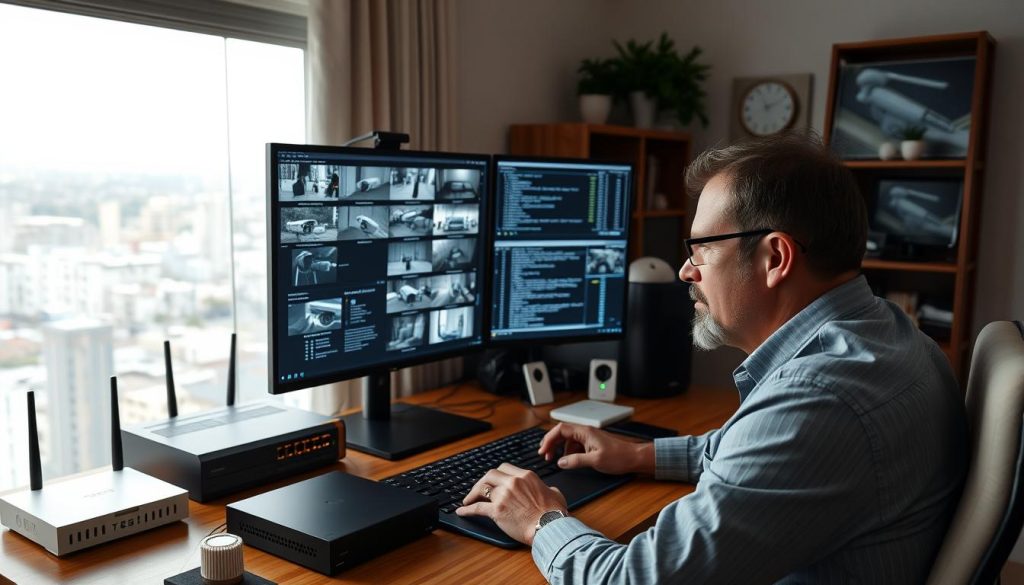
By following these best practices, you can make sure your surveillance systems follow data protection laws. This improves the safety and privacy of the data they manage.
Monitoring and Reporting Obligations
Home security cameras are becoming more common. It’s vital to know your monitoring and reporting duties under privacy laws. As a homeowner, you must protect your property and follow privacy rules for your cameras.
Privacy laws like GDPR and CCPA have specific rules for camera data. You need to know how to handle the data and what counts as a breach.
Keeping Records of Data Processing
Keeping accurate records of data processing is key. You must document the personal data collected, why it’s collected, and how it’s protected. Accurate record-keeping shows you follow privacy laws.
Your records should include:
- The types of personal data processed
- The reasons for collecting it
- Who gets the data
- Details of data sent to other countries
Reporting Data Breaches
If there’s a data breach, you must report it quickly. GDPR says to report within 72 hours, unless it’s not a big risk. Prompt reporting helps avoid penalties.
When you report a breach, give all the details. This includes what happened, who was affected, and what you’re doing to fix it.
By meeting your monitoring and reporting duties, you keep your camera use legal. This protects your property and the privacy of others.
The Future of Home Security Regulations
Home security laws are about to change a lot. With new tech, rules for home cameras and privacy will also change. It’s important to keep up with these updates to make sure your security systems are legal.
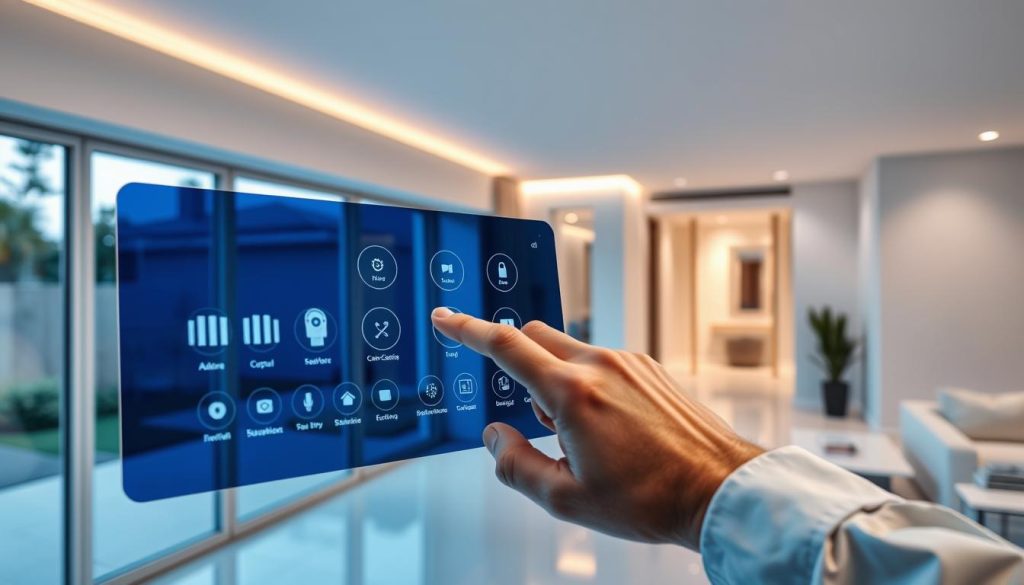
Potential Changes in Privacy Laws
Privacy laws like the California Consumer Privacy Act (CCPA) are leading the way in the US. New laws might make rules for home cameras stricter. You’ll need to update your security to follow these new rules.
Changes could include needing clearer consent for data use and stronger rights for people to control their data. For example, you might need to get explicit permission before collecting or sharing data.
Impact of Emerging Technology
New tech like Artificial Intelligence (AI) and Internet of Things (IoT) is changing home security. These techs bring better security but also raise privacy issues. When you add these to your security systems, think about how they affect privacy and security.
For example, AI cameras can watch your home live, but they collect a lot of data. It’s key to make sure this data is safe and follows privacy laws. Also, be ready for how these techs might change security laws.
Conclusion: Staying Compliant
It’s crucial to stay alert in your compliance efforts to avoid legal trouble. Keeping up with GDPR and CCPA rules takes constant work. You should check your practices often to make sure they follow the law.
Ongoing Compliance Efforts
To keep up with compliance, you must always check and improve your data handling. This means finding and fixing risks with your home security cameras.
Resources for Further Assistance
If you need more help, look at the GDPR and CCPA websites. You can also talk to legal experts who know about data protection. Training your team and using the latest tech can also help you stay in line.
